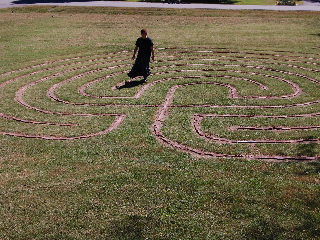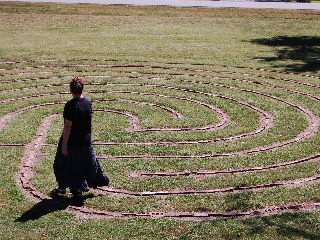
While the practice of gardening offers physical exercise for the body, many gardening enthusiasts find that the garden path also leads to a state of meditation and relaxation for the mind and the spirit.
If you want to go a step further in combining the physical and spiritual aspects of the gardening experience, consider adding a labyrinth to your landscape.
The history of the labyrinth dates back centuries, and its presence appears in varying forms across the rise and continuance of different civilizations as they sought to interpret their own physical and spiritual significance on the planet.
From the time of the pyramids in Egyptian history to the grandeur of early European churches and into the lives of the Native Americans, labyrinths have played a vital part in the meditative lives of humankind.
Although labyrinth designs vary in complexity and size, the classical labyrinth has seven circuits—this is an ancient design that dates back more than four thousand years.
Also, a true labyrinth has only one way in and one way out—differentiated from a maze that has branched pathways wherein the walker must make choices in order to navigate and complete the course. The beauty of this “one way” feature of the labyrinth is that it allows the user to meditate and enjoy the natural surroundings along the way without having to think about which path he should choose.
While there is no right or wrong way to walk the labyrinth, one suggested method is to hold the palms downward while walking in as a symbolic releasing of cares and stress—and then to turn and hold the palms upward while walking out as a symbol of receiving peace and harmony from your surroundings.
If you do choose to incorporate a labyrinth into your landscape, be sure you have enough space to build one (ideally an open area at least 43 feet by 43 feet). This allows for the seven circuits to each be about 3 feet wide, permitting enough room for those walking in and those walking out to comfortably pass each other.

The simplest materials to use in building your labyrinth might be natural stones (especially if you have ready access to these on your own property), or bricks (these can sometimes be purchased inexpensively if a source of re-cycled materials is close at hand).
If you want to go boldly into a beautiful (and more costly) gardening project, you could purchase and plant small privet, boxwoods, or other evergreens that could be shaped into a neat little hedge that defines the labyrinth.
Should you become inspired enough to take on a challenge of such proportions, you might consider building a labyrinth on a church property or on the grounds of some civic organization or park.
The purpose of this page is primarily to increase the gardener's awareness of the beauty, harmony, and uniquely interesting phenomenon that is the labyrinth.
More information, including a labyrinth locator, can be found at the website: labyrinthsociety.org
 While the practice of gardening offers physical exercise for the body, many gardening enthusiasts find that the garden path also leads to a state of meditation and relaxation for the mind and the spirit.
While the practice of gardening offers physical exercise for the body, many gardening enthusiasts find that the garden path also leads to a state of meditation and relaxation for the mind and the spirit.
 The simplest materials to use in building your labyrinth might be natural stones (especially if you have ready access to these on your own property), or bricks (these can sometimes be purchased inexpensively if a source of re-cycled materials is close at hand).
The simplest materials to use in building your labyrinth might be natural stones (especially if you have ready access to these on your own property), or bricks (these can sometimes be purchased inexpensively if a source of re-cycled materials is close at hand).